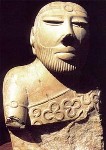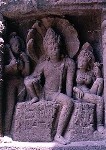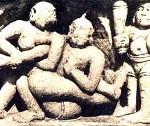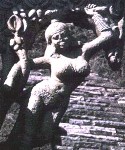Ancient India Artifacts
Indian people loved fine arts and indulged in dancing, sculpting and painting. This is revealed through the artefacts discovered by archaeologists and seeing them historians interpret some valuable facts about the lifestyle in ancient India.
These artefacts come to us right since the Indus valley civilization that belonged to Chalcolithic or Copper Age that's followed by the Iron Age during the Vedic period.
Indian sculptures are one of the earliest instances of sculpting in the world. India produced some of the most intricate sculptors in the world. These are unravelled in the art during the Hinduism, Buddhism and Jainism period of Indian History, in the carvings and sculpting in the temples and elsewhere.
These visual arts of India starting from the 3rd millennium BC can be classified into specific periods. This classification could be based on religious, political and cultural developments during different historical period of ancient India. Here we have for you fine gallery of Indian artefacts to relish and admire.
 The image is of a seated male sculpture with fillet or ribbon headband with circular inlay ornament on the forehead and similar but smaller ornament on the right upper arm. The two ends of the fillet fall along the back and though the hair is carefully combed towards the back of the head.
The image is of a seated male sculpture with fillet or ribbon headband with circular inlay ornament on the forehead and similar but smaller ornament on the right upper arm. The two ends of the fillet fall along the back and though the hair is carefully combed towards the back of the head.
Two holes beneath the highly stylized ears suggest that a necklace or other head ornament was attached to the sculpture. The left shoulder is covered with a cloak decorated with trefoil, double circle and single circle designs that were originally filled with red pigment.
Drill holes in the center of each circle indicate they were made with a specialized drill and then touched up with a chisel. Eyes are deeply incised and may have held inlay. The upper lip is shaved and a short combed beard frames the face. The large crack in the face is the result of weathering.

Ajanta Caves - Ancient India Artifacts
The Ajanta Caves in Aurangabad district of Maharashtra has about 30 rock-cut Buddhist cave monuments that date from the 2nd century BC to about 480 or 650 AD. The caves include paintings and sculptures are masterpieces of Buddhist religious art, with figures of the Buddha and depictions of the Jataka tales. The caves form the largest corpus of early Indian wall-painting.
Eal Mohenjo daro - Ancient India Artifacts
Large amount of seals are discovered at Mohenjo Daro. This image shows a person sitting in the lotus position of Yoga, an ancient discipline.

Yaksha - Ancient India Artifacts
Yaksha are nature-spirits, usually benevolent, who are caretakers of the natural treasures hidden in the earth and tree roots. They appear in Hindu, Jain and Buddhist literature. In Indian art, male yak?as are portrayed either as fearsome warriors or as portly, stout and dwarf-like. Female yak?as, known as yak?i?is, are portrayed as beautiful young women with happy round faces and full breasts and hips.

Wrestling in Ancient India
Wrestling has been a popular sport in ancient India. One of the premier characters in Mahabharata, Bhima was considered to be a great wrestler. Other great wrestlers included Jarasandha, Duryodhan, Karna etc. In Ramayana Hanuman is described as one of the greatest wrestlers of his time. The 13th century Malla Purana has the reference of a group of Gujarati Brahmin wrestlers known as Jyesthimallas.

Yakshi - Ancient India Artifacts
The three sites of Bharhut, Sanchi, and Mathura, have yielded huge numbers of Yakshi figures, most commonly on the railing pillars of stupas. These show a clear development and progression that establishes certain characteristics of the Yakshi figure such as her nudity, smiling face and evident feminine charms that lead to their association with fertility. The yakshi is usually shown with her hand touching a tree branch, and a sinuous pose. The foot of the tree is based on an ancient tree deity.

Karthikeya - Ancient India Artifacts
Kartikeya, the god of war and General of the Army of the gods, is known for his extraordinary strength. He has one hand in a charitable and the other in a protective pose. In many idols found in the Southern part of India, he is shown as having twelve arms. In ancient times his worship was very widespread and there are references about his images in homes and temples.

Yakshis - Ancient India Artifacts
The two yakshis who grasps, kicks, or twines herself around a tree is a symbol of fruitfulness, like the dryads of ancient Greek mythology, and a similar pose is often used in scenes of Maya giving birth to the Buddha, who emerges from her side.

Metal Products - Ancient India Artifacts
There are an array of metal products depicted in this picture. It ranges from farming equipment to household articles. Even some picture depicts hunting equipment, some vases and pots. All of them have varied use.

Indus Dancing Girl - Ancient India Artifacts
The bronze figurines of girl in dancing poses reveal the presence of some dance form in the Indus valley civilization. Sir John Marshall who discovered the famous Indus bronze statuette of the slender-limbed "dancing girl" in Mohenjo-daro said; when I first saw them I found it difficult to believe that they were prehistoric; they seemed to completely upset all established ideas about early art.
Indian Artifacts Identification
Its very dificult to be sure of identification of Indian Art and you have to trust known organisations for this. Similar to this is the indian artifacts value calculation. It all depends on the art collector and the whom of the seller.Contribute More Facts